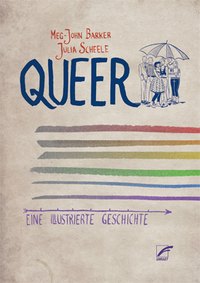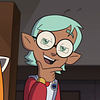Take a photo of a barcode or cover
1.06k reviews for:
Queer: Eine illustrierte Geschichte
Jennifer Sophia Theodor, Meg-John Barker, Julia Scheele
1.06k reviews for:
Queer: Eine illustrierte Geschichte
Jennifer Sophia Theodor, Meg-John Barker, Julia Scheele
Would I now prefer to consume all of my theoretical reading via graphic novel? Yes, yes I would. This was the book I never knew I needed! Also, a great overview of queer theory and they definitely got their point across that queer theory questions binaries (my head is still spinning with the both/and - but in a good way). Super interesting, super clear - I learned a lot.
Great overview and the illustrations were drawn beautifully.
I don’t want to give a rating because it doesn’t feel right to me but I’m confused as to who this book is targeted too. As someone who has *a little* knowledge of queer theory already I don’t feel like I learned anything necessarily new, but if this was my first approach to it I feel like I wouldn’t have understood anything of it.
Fine if you want a basic overview of queer theory, if you're one of many who have grown up with these concepts this book will not have anything to offer you.
Really could have done with a title change to emphasise the focus on queer theory and not a history of queerness.
Really could have done with a title change to emphasise the focus on queer theory and not a history of queerness.
A really digestible and approachable introduction, thank you.
challenging
informative
fast-paced
A well-rounded introduction to queer theory and various surrounding social matters such as various ways of identifying/identifying with a particular sexual orientation or gender identity (or lack thereof). Illustrations really draw one into the kaleidoscope that is queer theory--more properly queer theories, as I deduce from this book. The book and the art are highly intersectional (if you don't know what that means, you will learn in the book!)
One can argue with some or most of the statements within this, but I think most if not all bases are covered on the topic of queer theory. A great start for anyone who has dipped a toe or more into the natures of gender and sexuality as being other than inaccurately binary.
One can argue with some or most of the statements within this, but I think most if not all bases are covered on the topic of queer theory. A great start for anyone who has dipped a toe or more into the natures of gender and sexuality as being other than inaccurately binary.
informative
inspiring
reflective
fast-paced
A fun foray back into academia for a night! I think I'm not really the intended audience for this book, which is a graphic introduction to queer theory (the term history in the subtitle is a bit of a misnomer-- it'd be better if the cover and title made it clear it's about queer theory specifically). I've read fair number of the primary texts they refer to by Foucault, Butler, etc, so I doubt myself a bit when I say I think the concepts are well and clearly explained and that this book is pretty accessible. I'd be interested to hear the thoughts of readers who jumped into this without prior knowledge!
I especially liked how they addressed the lack of attention to race and bisexuality in most queer theory. I also appreciate that this is in graphic format; the topic doesn't really lend itself to graphic adaptation and I thought they did a good job with the visuals. It was fun to see pictures of the theorists I've read but never knew what they looked like!
Besides the misleading title, my only complaint is a kinda weird use of the word trans as a noun on its own (for example "writing about trans"). To be fair, some queer theorists also use the word queer in the same way and I find it similarly baffling. Oh and I wish the section on how to apply the concepts and ways of thinking to your everyday life were longer.
I especially liked how they addressed the lack of attention to race and bisexuality in most queer theory. I also appreciate that this is in graphic format; the topic doesn't really lend itself to graphic adaptation and I thought they did a good job with the visuals. It was fun to see pictures of the theorists I've read but never knew what they looked like!
Besides the misleading title, my only complaint is a kinda weird use of the word trans as a noun on its own (for example "writing about trans"). To be fair, some queer theorists also use the word queer in the same way and I find it similarly baffling. Oh and I wish the section on how to apply the concepts and ways of thinking to your everyday life were longer.
Barker and Scheele's Queer: A Graphic History is a succinct account of the academic field of queer theory. They go a long way to cut down on intensive (and confusing) jargon, and they succeed in providing many humorous and telling illustrations that reflect on queer icons throughout history while staying true to the political and cultural critiques endemic to queer theory. It's a text I would love to teach in the future, purely for its accessible reading, but also for its capacity to engender critical questions about the movements of queer theory. Additionally, students of queer theory might use this graphic novel as a primer for reading queerly or tackle the book head on to ask: why did Barker and Scheele choose Thinker A over Thinker B? In what ways does a historical mapping of the field create barriers or thresholds to innovation or turns in queer thinking?
The graphic novel receives five stars for a smooth read and positive register: for doing gender justice and focusing on ways for thinking about the future, that is, thinking critically about where we are and where we are heading.
The graphic novel receives five stars for a smooth read and positive register: for doing gender justice and focusing on ways for thinking about the future, that is, thinking critically about where we are and where we are heading.





